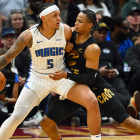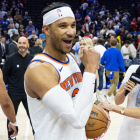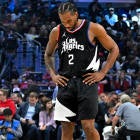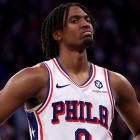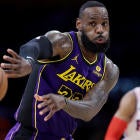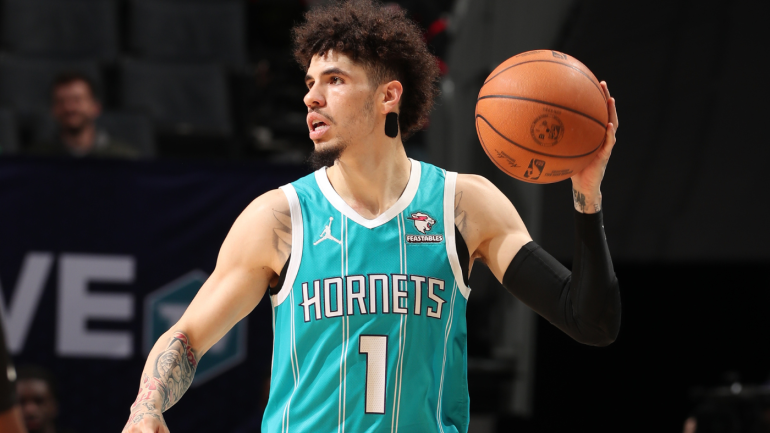
I can't yet decide if LaMelo Ball is a winning NBA player. I struggle with the same question regarding the Hawks' Trae Young. They're similar players, with Ball, generally speaking, just being the taller and probably slightly worse version.
What's interesting is that while Young came into the league with a reputation as a deadly 3-point shooter, Ball's shooting was supposed a major question mark.
So far, the opposite has been true of both.
Young, while being an elite passer with a masterful floater and midrange precision, has actually struggled pretty glaringly as a 3-point shooter. He's been 34% percent or worse in three of his first five NBA seasons; this season he's at 28%.
Ball, meanwhile, has connected on 39% and 38% of his 3s over his last two seasons, respectively, for the Hornets. Last year was a small sample, but he's doing it again this season at over 39%, a number that would be much higher if not for his slow start.
Over his last eight games, Ball is shooting 45% from deep on over nine attempts a night. In Charlotte's wild OT win over the Celtics on Monday, he finished with 36 points and eight assists on 5-of-11 from deep. That followed his 34-point showing against the Knicks on Saturday in which he hit 8-of-13 triples. That performance came off his 37 points against Milwaukee the night before.
All told, Ball, on high efficiency, has scored at least 25 points in eight straight games. He's hit the 30-point mark in six of those. The problem is, the Hornets are 2-6 over that stretch, and one of those wins was against the Wizards, which almost doesn't count. Entering Monday, the Hornets had lost Ball's minutes by a combined 95 points, which ranked as the 463rd worst mark among 476 players this season.
Even in the win over Boston, Ball was only plus-3, while Brandon Miller and Gordon Hayward, with almost identical minute totals, were plus-22 and plus-20, respectively.
Plus-minus numbers are more a team stat than a person one, but they should, over a large enough sample, point you in the direction of positive players. In particular, players with as much control over their statistical fate like Ball, who is in total control of Charlotte's team.
Charlotte is bad, and you only need to barely watch them play to know that Ball is the best player on the team and a legit All-Star talent. He does multiple things every game -- things that are often reserved for superstar talents. He's a true difference-making passer, nearly a top-five assist man this year with tremendous lob and hit-ahead feel.
But again, truth be told, his biggest impact on the floor lies behind the 3-point line, which was supposed to be a weakness. He's equally proficient off the dribble and catch, and his range is more or less limitless. Put him inside the 3-point line, though, and he's hit or miss, with a historic lean to the latter.
It's hard to strictly classify Ball's mid-range shots. You could call them floaters, runners, push shots; what you can't call them is a jumper. He almost never takes just a regular, set mid-range jump shot. It's always some version of forward-leaning flick, often off one foot, from around the free-throw line, and these shots don't go down all that much.
Per Synergy, Ball's 1.05 points per shot at the rim registers in the 20th percentile among 298 qualified players. It's been that way all his career.
Entering play on Monday, he was 20-for-50 from from between 5-14 feet, per NBA.com tracking. It's been that way all his career.
Ball's 40% midrange and 54% at-rim conversion rates are both well below league average for his position, per Cleaning the Glass. So are is his 51.3 effective field-goal% and 113.6 points per 100 shot attempts. Stop me if you've heard this before, but it has been this way all his career.
That's a nerdy way of saying he's a wildly inefficient scorer from inside the arc, even though he does probe the lane and get into the paint very effectively. His touch on those in-between runners/floaters often look soft and natural when he makes them, like that part of his game should improve.
Still, the guy is a 25 PPG scorer and top-flight distributor on almost 40% 3-point shooting. These are major numbers. It's just going to be hard to know exactly what they equate to with respect to winning until Charlotte puts a better team on the floor.
For my money, I just don't see Ball as a winning player. He can be one, and is, on certain nights a winner, as was the case on Monday. He's so talented that a certain amount of wins will be a byproduct of his counting production -- or at least they should be if this Hornets team, which has some promising young talent in Miller, P.J. Washington, Mark Williams and Miles Bridges, develops together.
Still, there's something missing in Ball as a guy who is going to gets you wins at the highest level. He still feels like more of a showman, much like Young, who can't lean on one playoff run through a bracket that broke his way forever.
To me, Tyrese Haliburton is the winning version of Ball. At a glance, they have similar games; aesthetically, they even look similarly unconventional. But Haliburton, while just being a little better at all the things Ball is good at, just adds up to more. I'm not sure how to define it because any on-off splits can be quantified by Indiana's superior roster.
That said, Indiana isn't some juggernaut. Haliburton gets more out of that team, and has since his first game, than Ball gets out of Charlotte or Young gets out of Atlanta.
I could be wrong about all this. Ball is a tremendous talent, and his size alone should make him at least a neutral defender if he ever finds himself in meaningful games. But, right now, to me, these numbers don't add up to quite as much you would think they do.















